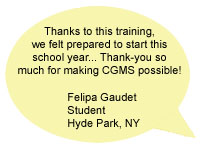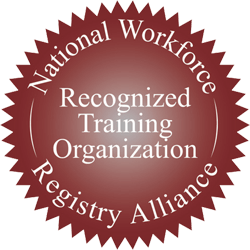“From such a system there comes forth a school where the children work for themselves – that is, they are free. In this freedom they work much more than heretofore has been customary in school…
and they attain culture more rapidly and more efficaciously… This educational problem, which today science propounds, is solved, though it was considered among the insoluble questions such as the fourth dimension, perpetual motion, and the squaring of the circle. The problem is to lessen effort and at the same time increase output.”
|
||||||||||||||||
| (A Montessori quick bite from The Center for Guided Montessori Studies) | ||||||||||||||||
|
A century ago, Dr. Montessori discovered that freedom and excellence are intertwined. Both children and adults today could benefit from applying this insight to our schools and work places. Our traditional school systems are built like our traditional factories. Even the end-of-period bell mimics the shift-break bell in an industrial facility. Having once worked in a traditional factory myself, I can attest that the similarity of cultures continues to this day, authoritarian and unstimulating environments where questioning and collaboration are both disdained. In fact, the traditional school system was designed in tandem with the support of early "efficiency experts" with the goal of producing ready workers for industrial expansion. It’s curious that today we still find these alienating attitudes in our workplaces and schools. Not just our educators, but our business leaders also should know better. In the 1980s, businesses around the world began to take note of unusually efficient processes at automotive factories in Germany and Japan. These factories produced more cars at lower cost and with fewer errors, yet oddly they upended a great deal of standard practice. Consultants discovered that these workers collaborated more, especially with management. However, there was one extremely startling difference at the most successful of these factories. In traditional factories, such as the one I worked at, workers’ responsibilities are quite constrained. For example, my job was to put rubber gaskets on circuit boards. I couldn’t go too fast or too slow lest I risk disrupting the production queue. Because of union rules and shop practice, I was not to inspect the parts for any problems, so I needed to ignore even the most glaring defects which would render the final devices useless. My job, like many others, was essentially to "pull a lever." It was certainly dispiriting, but it also struck me at the time as rather inefficient. In contrast to the one I worked at, consultants found that at the most effective factories, worker responsibilities were extended beyond the rapid production of the next part to encompass the overall quality of the product. Workers who spotted any defect were allowed to call a halt to production if necessary. These workers weren’t just pulling levers, they knew the purpose of their work and felt ownership and pride over the output of the factory. Work should be ennobling, but far too frequently it is not. Way back in 1968, a management consultant by the name of Fredrick Herzberg studied workplace efficiency and concluded that the intrinsic motivators of work (the pleasures of the job itself) outweighed the motivation of extrinsic factors such as pay, vacation or even the perks of the work environment. Obviously people need to be fairly compensated for their work in order to feel motivated, but beyond that point extra dollars did not lead to extra effort. Things that did included providing employees with the freedom to accomplish tasks in the ways best suited them, and extending their responsibilities "vertically" to encompass more of the work process. The more responsibility offered an employee, the greater their own reported sense of satisfaction. This contrasted against the negative effects of "horizontal" job loading an employee, for example by challenging them to tighten twice as many bolts in a day. In Montessori, too, we talk about intrinsic motivation as superior to extrinsic motivators such as grades or even praise. In fact, Herzberg’s studies of adults show that intrinsic motivators produce superior results, one more way the Montessori method better prepares children for the real world. It is interesting today that despite the fact that we know we both learn and work best when we are interested, schools and workplaces are still constructed around the premise that students and workers are adversaries of teachers and employers respectively. If we treat children and adults as if they can’t be trusted to want to do their work, is it surprising that they don’t act like they want to be at their schools and offices? Is it surprising that our schools are failing, or that workplace productivity is lagging? These are direct cultural and economic consequences that follow from the way people are treated. If we assume students do not wish to learn, then we get bored students who learn less and even goof off. Assume employees don’t want to work and risk being forgotten like Altavista. This once leading search engine has been rendered obsolete by one where employees are encouraged to spend a day a week on any problem of their choosing. This is Google, a company founded by two former Montessori children. The table below is from Frederick Herzberg’s original 1968 article in Harvard Business Review. See if you spot any similarities between the principles Herzberg enumerated and those we hold fast to as Montessori educators.
Herzberg’s chart suggests the value of removing controls while increasing personal accountability. This brings to mind the delicate balance of freedom and responsibility that is essential in a Montessori classroom. This balance is often a Montessori teacher’s greatest challenge. Reflecting on how well we achieve this balance with each individual child and our class as a group is an important part of our daily spiritual preparation. Today the wisdom of Dr. Montessori is reaching an ever greater number of people, and we see more and more public Montessori schools opening around the world. And as we have seen, some of the most successful companies are applying similar principals in there workplaces. Nonetheless, the majority of schools and workplaces have not yet adopted the respectful and humanistic practices that we know lead to better outcomes. Our work continues!
|




